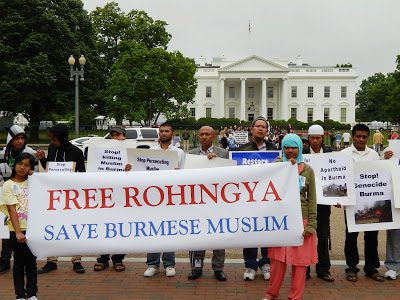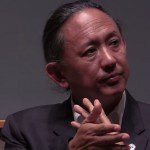Coming just off the heals of the 20th anniversary of the beginning of the Rwandan genocide, we are called ever more clearly to understand conflicts in the world that might lead to such horrors. What is happening in Burma today eerily reflects the ethnic divides and hateful rhetoric that precipitated the murder of over 800,000 Rwandans (primarily ethnic Tutsis) in 1994.
In addition to attacks in recent years, this January, mobs of (ethnic Rakhine) Buddhists massacred Rohingya Muslims in the western Rakhine state. Since then towns and businesses have been targeted and tens of thousands of Rohingya Muslims have become refugees in their own country, locked up in guarded encampments with little access to food, water, and basic medicine. Many, perhaps thousands, have drowned trying to escape by sea to Bangladesh or Malaysia. For some who survived such trips, the result was to simply be sent away, back to sea. Others still have been enslaved by Thai fishermen, wound up packed for months in Thai cages, or entered into cycles of human trafficking. Recently, major aid groups have also been attacked, forcing many to leave. Others, such as Doctors Without Borders, has been ordered out by the government.*
The situation in Burma is dire.

The responsibility of academics is often to discuss the historical, religious, political, and other aspects of world events as they play out in order to get to the exact nature of what is happening. In case you missed it, my friends Danny Fisher and Paul Fuller have had some interesting discussion around the topic of recent violence on the part of Buddhists in Burma.
- Ethnocentric Buddhism: A new theme in Burmese Buddhism by Paul Fuller (you can read more from him at his blog here)
- “Ethnocentric Buddhism?” by Danny Fisher
For a while now, scholars have been debating and discussing how we should understand the recent violence on the part of Buddhists in these two countries. Avid readers of this blog will have some sense of my stance on categories. Basically we use what is useful. As we go, we seek greater degrees of precision while simultaneously drawing in alternative points of view. I don’t see anyone arriving at any final ‘right’ answer, nor will there ever be just one perspective, but there is value in continuing the conversation. In my own writing I have used phrases such as “Fundamentalism” as a problem in Buddhism and other religions, a (good) Fundamentalism or Protestant ideal, globalized “Buddhist anti-Muslim Hate” and perhaps most (in)famously, “American Buddhist Terrorist?“.
Here Paul has coined a new term, “Ethnocentric Buddhism” which he states, “points to the notion that Buddhist identity is intrinsically linked to national identity. It also denotes the idea that other factors will be apparent in creating Buddhist and national identity in different Buddhist cultures… the defence of one’s religion is linked to these other themes of national identity — to defend one is to defend the other.”
Danny responded that, “I confess, though, I was left wondering what exactly would be wrong with using terms like “Buddhist terror” or “Buddhist extremism” to describe some of the situations that precipitated Fuller’s article.” He continues, after discussing recent events in Burma, “Is “ethnocentric Buddhism,” then, really helping us understand the full extent of these particular phenomena? Or does it fail in these cases to capture some of the horrible realities here?”
Certainly any acute acts of terrorism, and those who support those acts in their words are well defined with “Buddhist terror.” “Buddhist extremism” is likewise useful for those groups and individuals who clearly stand out from the mainstream in a society, but this too can be a difficult label.
I would add though to Danny’s excellent questions that what Paul is describing might also be “Buddhist nationalism” or, if you prefer, “nationalistic Buddhism,” akin perhaps to how many people (mostly Evangelical Christians) discuss American Exceptionalism, or Zionism amongst certain Orthodox Jews. Here we have a clear religion-state connection.
The label “ethnocentric Buddhism” might be helpful in covering something much broader existing in these two countries, something we too often overlook. That is the broader ethnic chauvinism displayed by dominant ethnic groups, Sinhala and Bamar respectively, toward other ethnic groups in the country. You can read this article on Sinhala chauvinism to catch up on this angle on events in Sri Lanka. In Burma we must remember that it is not simply Buddhists vs Muslims, but rather a central government dominated by the Bamar ethnic group who are at war with numerous groups around the country: the Kachin in the north, the Shan in the east, and the Karen in the south. The ethnocentrism of the Rakhine Buddhists may not necessarily be nationalistic in nature – though it is certainly supported by the Bamar central government.
A general mood of distrust and even antagonism toward an ethnic or religious minority in a country might not be extreme (as it is pervasive) and it might not manifest in particular acts of terror, thus necessitating a new label such as “ethnocentric” or “nationalistic” Buddhism. Such a category could be used to designate attitudes and actions of religious leaders long before any overt extremism or acts of terror occur. Indeed, Paul alludes to this in his article when he writes:
There are a number of possible factors and ideas that could shape the formation of an ethnocentric type of Buddhism in a given country. Not all of these ideas are available in each cultural context. Some are available across Buddhist Asia, some confined to a particular area, or would have been used during different historical periods. There is the idea of the “true dharma” existing in one particular place and of that location preserving this true version of the Buddha’s teachings. For example, in Sri Lanka after the transmission of Buddhism, some aspects of the Pali Canon would be considered to preserve the essential word of the Buddha. Later, national identity could be built around this idea together with other texts being used and composed together with Buddhist symbols, the tooth relic for example, creating the notion of a direct lineage to the Buddha.
With a category such as “ethnocentric Buddhism” we could examine instances and perhaps frequency of claims to having “true dharma” and specific objects (relics, holy places, etc) that might need to be “defended” from outsiders.
So far we are only in the beginning stages of understanding this phenomenon, so I am glad to see Paul’s article and Danny’s response. I’m happy also to see that a conference will convene in London in just over a week to discuss the situation in Burma.
Regardless of what exactly we call it, it is necessary for people around the world, and particularly in Sri Lanka and Burma, to speak out against these acts of violence. In that vein, I offer this video:
* Read more on Burma here, and this account from a Western aid-worker.












